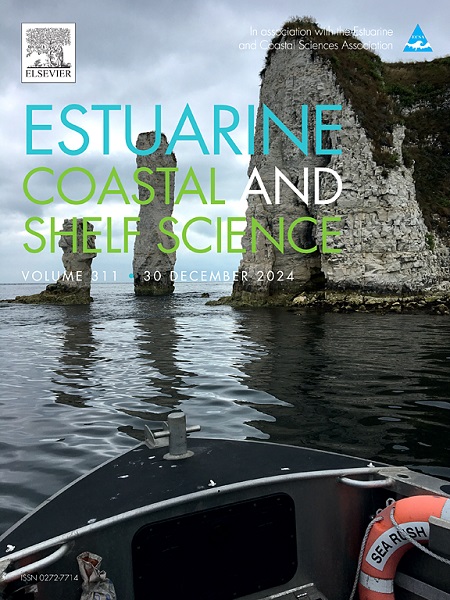北卡罗莱纳州潮汐沼泽降水驱动的溶解有机碳通量冬春动态
IF 2.6
3区 地球科学
Q1 MARINE & FRESHWATER BIOLOGY
引用次数: 0
摘要
溶解有机碳(DOC)的横向迁移在潮汐沼泽碳收支中起着至关重要的作用,但由于陆水界面的动态性和原位观测的局限性,DOC的估算仍然是一个挑战。本研究采用线性模型将DOC与CDOM在440 nm处的吸收系数(aCDOM(440);r2 = 0.75),在美国北卡罗来纳州的秃头溪。将模拟的DOC浓度与半隐式跨尺度水文科学综合系统模式(SCHISM)得出的流速合并,估算2021年1 - 4月的DOC日通量,代表北半球中纬度地区的冬季和春季。DOC通量与季节和潮汐有关,负值代表DOC输入沼泽,正值代表DOC输出河口。结果表明,DOC在2月和3月降水高峰后从湿地输出;潮汐淹没和降水带来的河流流量增加对DOC通量有影响,但在研究期间,DOC的日平均输入量(- 13.6±6.0 g C m−2 d−1)大于DOC的日平均输出量(9.4±8.3 g C m−2 d−1),表明初春湿地是DOC的净汇。该研究表明,使用SCHISM等模式进行的现场测量提供了DOC通量的天气学表征,其中降雨引起的河流流量影响DOC的动员并向Bald Head Creek等沿海系统输出。本文章由计算机程序翻译,如有差异,请以英文原文为准。
Winter-Spring dynamics of dissolved organic carbon fluxes driven by precipitation in a North Carolina tidal marsh
The lateral transport of dissolved organic carbon (DOC) is crucial in tidal marsh carbon budgets, but estimating DOC remains a challenge due to the dynamic nature of terrestrial-aquatic interfaces and limitations of in situ observations. This study used a linear model to correlate DOC and chromophoric dissolved organic matter (CDOM) absorption coefficient at 440 nm (aCDOM(440); r2 = 0.75) in Bald Head Creek, North Carolina, USA. Modeled DOC concentrations were merged with current velocity derived from the Semi-implicit Cross-scale Hydroscience Integrated System Model (SCHISM) to estimate daily DOC fluxes from January to April 2021, representing winter and spring in the mid-latitude northern hemisphere. DOC flux depended on season and tide, where negative values represent DOC import into the marsh and positive values represent export to the estuary. Results showed that DOC was exported from the marsh in February and March after peak rainfall. While tidal inundation and increased river flow from precipitation influenced DOC flux, the average daily DOC import of −13.6 ± 6.0 g C m−2 d−1 was greater than the average daily DOC export of 9.4 ± 8.3 g C m−2 d−1 during the study period, showing that the marsh was a net sink for DOC during the early spring. This study demonstrated that field measurements with models like SCHISM provided a synoptic representation of DOC flux, where rainfall-induced river discharge impacts DOC mobilization and export to coastal systems like Bald Head Creek.
求助全文
通过发布文献求助,成功后即可免费获取论文全文。
去求助
来源期刊
CiteScore
5.60
自引率
7.10%
发文量
374
审稿时长
9 months
期刊介绍:
Estuarine, Coastal and Shelf Science is an international multidisciplinary journal devoted to the analysis of saline water phenomena ranging from the outer edge of the continental shelf to the upper limits of the tidal zone. The journal provides a unique forum, unifying the multidisciplinary approaches to the study of the oceanography of estuaries, coastal zones, and continental shelf seas. It features original research papers, review papers and short communications treating such disciplines as zoology, botany, geology, sedimentology, physical oceanography.

 求助内容:
求助内容: 应助结果提醒方式:
应助结果提醒方式:


